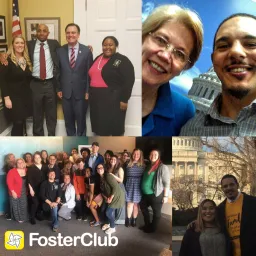On February 9th, 2018, the Family First Act (FFA) was signed into law. The historic passing of the FFA would not have occurred without the voices of Lived Experience Leaders (LEx) joining FosterClub in promoting and supporting the passing of the FFA. As we celebrate the five year anniversary of the Family First Act, FosterClub reflects on how this historic legislation has helped young people at risk of entering care or currently in care, and the words of our LEx who helped make this law possible.
What is the Family First Act?
The Family First Act is a piece of federal legislation that allocated funding towards:
- Prevention services
- Supporting kinship (relative) caregivers
- Improving services to older youth
The Family First Act also established requirements for placing youth in residential treatment facilitites and improving the quality and oversight of services1.
How does the Family First ace help youth at risk of entering care or currently in care?
- By funding prevention services, the FFA helps ensure that youth are not unnecessarilly removed from their families
"If we were to advocate more for families who live in poverty (they just need an extra push and resources) less youth and children would enter the foster care system."
Youth in/from care, MN2
- By funding supports for kinship (relative) caregivers, the FFA increases the chances that youth placed with kinship caregivers can experience a succesful placement, permanency, and thrive
"Caregivers need support, from financial assistance, respite care, legal advice, and understanding."
Roberta, Kinship Caregiver from Pennsylvania3
- By improving services to older youth and extending the age of eligibility for services, the FFA ensures that youth aging out of foster care get necessary supports to help them successfully transition into adulthood
"When we are in foster care, all of our major basic needs are met almost automatically...The problem is that we are not prepared to complete these tasks for ourselves."
Former Foster Youth, NJ4
- By establishing requirements for placing youth in congregate settings, the FFA ensures that youth are placed in the least restrictive setting possible and that congregate settings are only utilized for treatment purposes, not due to a lack of available foster parents
"I was in a group home placement for a couple of months...When I come to think of group homes, I come to think of them as more of a 'restrictive placement.' It is no place for a child to grow..."
Ashley5
FosterClub thanks Lived Experience Leaders (LEx) who came together to promote and support the passing of the Family First Act. Learn more about how LEx helped to pass the FFA here.
Sources:
1Family First Act: About the Law
2Prevention: Strengthening Families and Averting Crises
5Improving Policies and Services in Congregate Care Settings: Our Priorities

